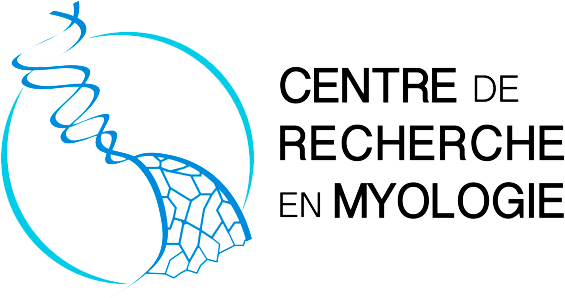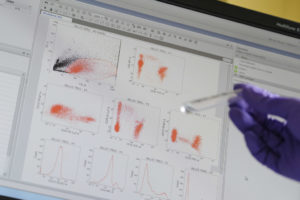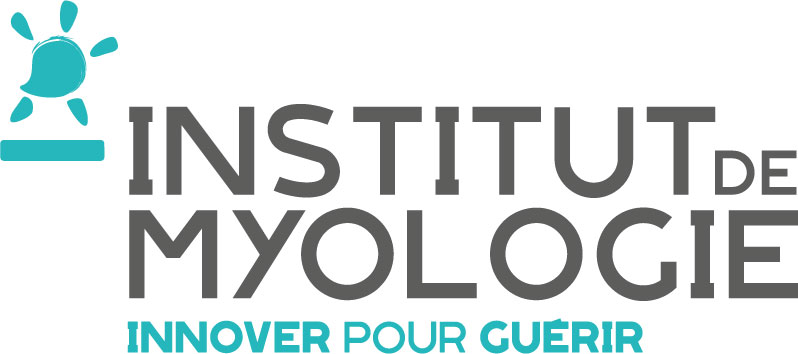Muscle cell organization and therapy of dominant centronuclear myopathy
Muscle cell organization and therapy of dominant centronuclear myopathy
Strengthening knowledge on fundamental aspects of muscle biology is one central challenge in order to decipher pathomechanisms and identify targets for therapeutic intervention for neuromuscular disorders. This is particularly true for diseases due to mutations in genes encoding proteins with pleiotropic roles such as autosomal dominant centronuclear myopathy (CNM) due to mutation of the ubiquitously expressed Dynamin 2 (DMN2) involved in endocytosis, intracellular membrane trafficking and cytoskeleton regulation. In this context, the objectives of the team are: i) to dissect fundamental mechanisms of muscle cells, relevant to understand the dominant CNM, and beyond, numerous other neuromuscular disorders, and ii) to develop experimental therapies for the dominant CNM and study the adeno-associated virus (AAV) vectors fate in pathological muscles to optimize AAV-mediated therapies for neuromuscular disorders. With these objectives, we are developing several projects:
– Role of the endocytosis machinery in mechanobiology at the costameres in healthy and pathological muscles with a particular focus on its adhesive properties and the interplay with mechanosensitive pathways. We also want to better understand how alternative splicing events of the endocytosis machinery cooperates, upon differentiation, to govern clathrin structural diversity (Stéphane Vassilopoulos).
– Role of mechanical stress in muscle homeostasis and growth under physiological and pathological conditions, with a particular focus on the force-mediated regulation of plasma membrane and nuclear stiffness and deformations, chromatin and histone modifications, and genetic programs in muscle cells. We also want to determine how muscle differentiation impacts nuclear characteristics (Catherine Coirault).
– The cellular and molecular mechanisms involved in ventilation-induced diaphragm dysfunction in particular during aging, and the muscle dysfunction occurring in patients in intensive care unit (Catherine Coirault and Adrien Bouglé).
– By combining genetic modifications, live imaging, biophysics, cellular and animal models, we aim at deciphering the pivotal influence of the nucleo-cytoskeleton connection on cell phenotype and genome organization in particular in the context of muscle formation and cardiomyopathy (Bruno Cadot).
– Preclinical development of the allele-specific silencing therapy for the dominant CNM and other DNM2-linked diseases and first proof of concept of allele-specific therapy for other dominant diseases. In addition, we want to develop pharmacological therapy for the DNM2-linked CNM patients (Delphine Trochet & Marc Bitoun).
– In order to optimize AAV-based therapies, we want to identify cellular factors impacting the efficiency of AAV-mediated transduction in diseased muscles. We are focusing on mechanisms regulating the AAV intracellular trafficking and to improve AAV-mediated therapies in DMD and CNM animal models by pharmacological co-treatments (Sofia Benkhelifa-Ziyyat).
Team members:
- Marc Bitoun. Research Director INSERM, co-team leader
- Stéphane Vassilopoulos. Research Director INSERM, co-team leader
- Catherine Coirault. Research Director INSERM
- Delphine Trochet. Research scientist Association Institut de Myologie
- Sofia Benkhelifa-Ziyyat. Research scientist Association Institut de Myologie
- Bruno Cadot. Research scientist Association Institut de Myologie
- Bernard Prudhon. Research Assistant Association Institut de Myologie
- Lylia Mekzine. Research associate INSERM
- Marion Benoist. PhD Student Sorbonne University. Email:
- Kevin Milliet. Master student.
- Ines Akrouf. PhD Student Sorbonne University. Email :
- Joana Martins. PhD Student Sorbonne University. Email :
- Satish Moparthi. Post doc. Email :
- Marine Dumas. Research Assistant AIM. Email :
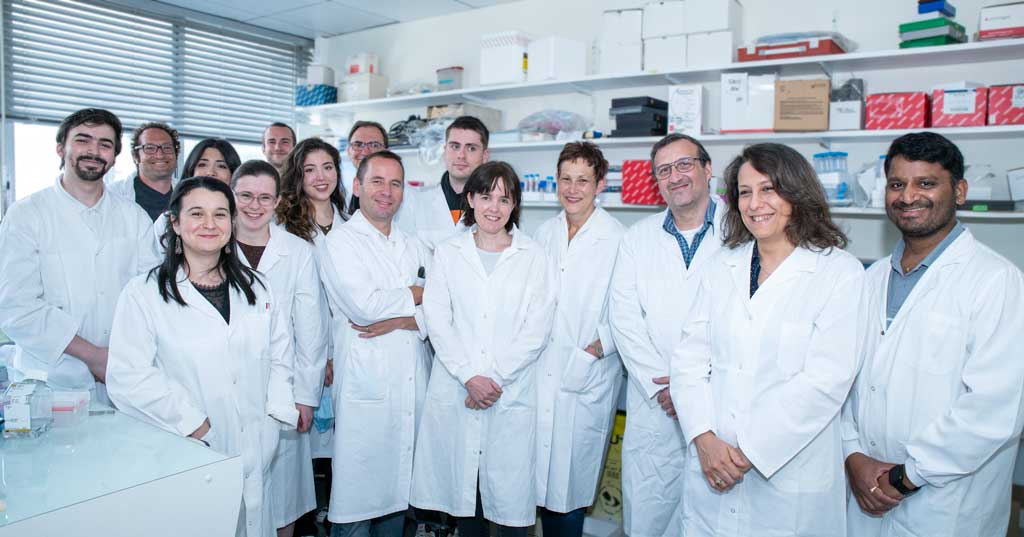
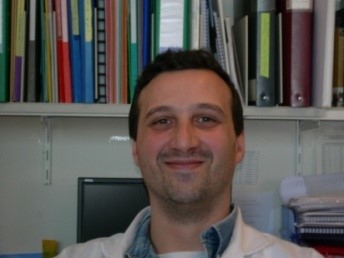
Contact:
| Name | Position | ORCID |
|---|
- Marc Bitoun. Pathophysiological mechanisms and therapy for the autosomal dominant centronuclear myopathy due to Dynamin 2 mutations. Journées de la Société Française de Myologie, 2022, Toulouse, France. ⟨hal-03875396⟩
- Gökçe Agsu, Jérémie Gaillard, Bruno Cadot, Laurent Blanchoin, Emmanuelle Fabre, et al.. Reconstituting the Interaction Between Purified Nuclei and Microtubule Network. Hiroshi Inaba. Microtubules. Methods and Protocols, 2430, Springer US, pp.385-399, 2022, Methods in Molecular Biology, ⟨10.1007/978-1-0716-1983-4_25⟩. ⟨hal-03687555⟩
- Swati Dudhal, Lylia Mekzine, Bernard Prudhon, Karishma Soocheta, Bruno Cadot, et al.. Development of versatile allele-specific siRNAs able to silence all the dominant dynamin 2 mutations. Molecular Therapy - Nucleic Acids, 2022, 29, pp.733-748. ⟨10.1016/j.omtn.2022.08.016⟩. ⟨hal-03778880⟩
- Delphine Trochet, Bernard Prudhon, Lylia Mekzine, Mégane Lemaitre, Maud Beuvin, et al.. Benefits of therapy by dynamin-2-mutant-specific silencing are maintained with time in a mouse model of dominant centronuclear myopathy. Molecular Therapy - Nucleic Acids, 2022, 27, pp.1179-1190. ⟨10.1016/j.omtn.2022.02.009⟩. ⟨hal-03659054⟩
- Trochet Delphine, Dudhal Swati, Mekzine Lylia, Prudhon Bernard, Cadot Bruno, et al.. Development of versatile allele-specific siRNAs able to silence all the dominant dynamin 2 mutations. Journées de la Société Française de Myologie, 2022, Toulouse, France. 2022. ⟨hal-03875467⟩
- Cadot Bruno. Nucleus-cytoskeletons connections in muscle. Merlion Workshop, 2022, Singapour, Singapore. ⟨hal-03946252⟩
- Delphine Trochet, Marc Bitoun. Allele-specific siRNA therapy for Dynamin 2-related diseases. France, Patent n° : EP22306213.4. 2022. ⟨hal-03968508⟩
- Muhammad Haseeb Iqbal, Jeanne Rosine Faratiana, Emeline Pradel, Varvara Gribova, Kamel Mamchaoui, et al.. Brush-Induced Orientation of Collagen Fibers in Layer-by-Layer Nanofilms: A Simple Method for the Development of Human Muscle Fibers. ACS Nano, In press, ⟨10.1021/acsnano.2c06329⟩. ⟨hal-03832239⟩
- Ines Akrouf. Modulation of intracellular pathways involved in the AAV trafficking to optimize AAV-based therapies in Duchenne muscular dystrophy and autosomal dominant Centronuclear Myopathy. Journées de la Société Française de Myologie, 2022, Toulouse, France. ⟨hal-03875378⟩
- Gilles Moulay, Marc Bitoun, Denis Furling, Steṕhane Vassilopoulos. Comment l’épissage alternatif contribue au contrôle de la plasticité des structures de clathrine. Médecine/Sciences, 2021, 37 (12), pp.1186-1188. ⟨10.1051/medsci/2021178⟩. ⟨hal-03498232⟩
